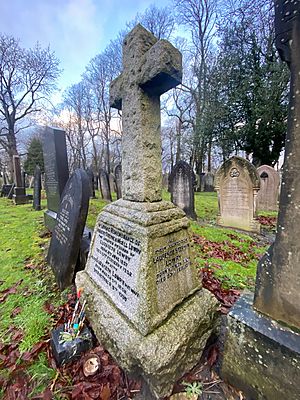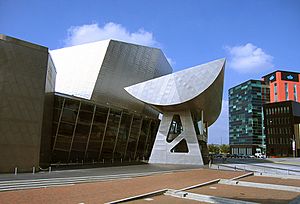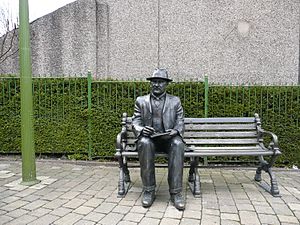L. S. Lowry facts for kids
Quick facts for kids
Laurence Stephen Lowry
RBA RA
|
|
|---|---|
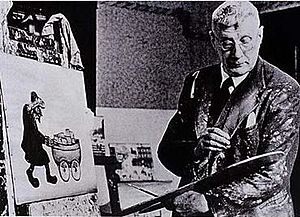
Lowry at work
|
|
| Born |
Laurence Stephen Lowry
1 November 1887 Stretford, Lancashire, England
|
| Died | 23 February 1976 (aged 88) Glossop, Derbyshire, England
|
| Education | Manchester Municipal College Salford Technical College |
| Known for | Painting |
|
Notable work
|
|
| Awards | |
Laurence Stephen Lowry RBA RA ( LAO-ree; 1 November 1887 – 23 February 1976) was an English artist. His drawings and paintings mainly depict Pendlebury, Lancashire, where he lived and worked for more than 40 years, Salford and its vicinity.
Lowry is famous for painting scenes of life in the industrial districts of North West England in the mid-20th century. He developed a distinctive style of painting and is best known for his urban landscapes peopled with human figures, often referred to as "matchstick men". He painted mysterious unpopulated landscapes, brooding portraits and the unpublished "marionette" works, which were only found after his death.
His use of stylised figures, which cast no shadows, and lack of weather effects in many of his landscapes led critics to label him a naïve "Sunday painter".
Lowry holds the record for rejecting British honours (five), including a knighthood (1968). A collection of his work is on display in The Lowry, a purpose-built art gallery on Salford Quays. On 26 June 2013, a major retrospective opened at the Tate Britain in London, his first at the gallery; in 2014 his first solo exhibition outside the UK was held in Nanjing, China.
Contents
Early life
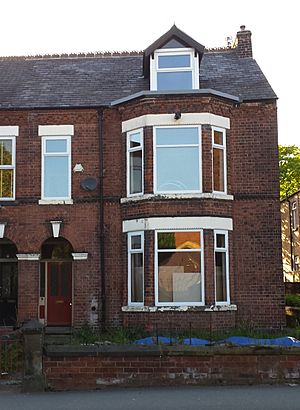
Lowry was born on 1 November 1887 at 8 Barrett Street Stretford, which was then in Lancashire. It was a difficult birth, and his mother Elizabeth, who hoped for a girl, was uncomfortable even looking at him at first. Later she expressed envy of her sister Mary, who had "three splendid daughters" instead of one "clumsy boy". Lowry's father Robert, who was of Northern Irish descent, worked as a clerk for the Jacob Earnshaw and Son Property Company and was a withdrawn and introverted man. Lowry once described him as "a cold fish" and "(the sort of man who) realised he had a life to live and did his best to get through it."
After Lowry's birth, his mother's health was too poor for her to continue teaching. She is reported to have been a religious woman who was talented and respected, with aspirations of becoming a concert pianist. She was also an irritable, nervous woman brought up to expect high standards by her stern father. Like him, she was controlling and intolerant of failure. She used illness as a means of securing the attention and obedience of her mild and affectionate husband and she dominated her son in the same way. Lowry maintained that he had an unhappy childhood, growing up in a repressive family atmosphere. Although his mother demonstrated no appreciation of her son's gifts as an artist, a number of books Lowry received as Christmas presents from his parents are inscribed to "Our dearest Laurie". At school he made few friends and showed no academic aptitude. His father was affectionate towards him but was, by all accounts, a quiet man who was at his most comfortable fading into the background as an unobtrusive presence.
Much of Lowry's early years were spent in the leafy Manchester suburb of Victoria Park, Rusholme, but in 1909, when he was 22, due to financial pressures, the family moved to 117 Station Road in the industrial town of Pendlebury. Here the landscape comprised textile mills and factory chimneys rather than trees. Lowry later recalled: "At first I detested it, and then, after years I got pretty interested in it, then obsessed by it ... One day I missed a train from Pendlebury – [a place] I had ignored for seven years – and as I left the station I saw the Acme Spinning Company's mill ... The huge black framework of rows of yellow-lit windows standing up against the sad, damp charged afternoon sky. The mill was turning out ... I watched this scene — which I'd looked at many times without seeing — with rapture ..."
Education
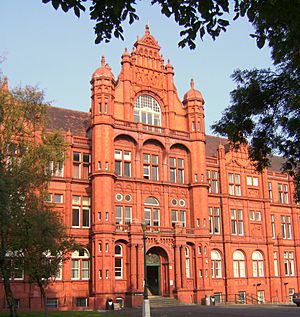
After leaving school, Lowry began a career working for the Pall Mall Company, later collecting rents. He would spend some time in his lunch hour at Buile Hill Park and in the evenings took private art lessons in antique and freehand drawing. In 1905, he secured a place at the Manchester School of Art, where he studied under the French Impressionist, Pierre Adolphe Valette. Lowry was full of praise for Valette as a teacher, remarking "I cannot over-estimate the effect on me of the coming into this drab city of Adolphe Valette, full of French impressionists, aware of everything that was going on in Paris". In 1915 he moved on to the Royal Technical Institute, Salford (later to become the Royal Technical College, Salford and now the University of Salford) where his studies continued until 1925. There he developed an interest in industrial landscapes and began to establish his own style.
Lowry's oil paintings were originally impressionistic and dark in tone but D. B. Taylor of the Manchester Guardian took an interest in his work and encouraged him to move away from the sombre palette he was using. Taking this advice on board, Lowry began to use a white background to lighten the pictures. He developed a distinctive style of painting and is best known for his urban landscapes peopled with human figures, often referred to as "matchstick men". He also painted mysterious unpopulated landscapes, brooding portraits and the unpublished "marionette" works, which were only found after his death.
Death of his parents
His father died in 1932, leaving debts. His mother, subject to neurosis and depression, became bedridden and dependent on her son for care. Lowry painted after his mother had fallen asleep, between 10:00 p.m. and 2:00 or 3:00 a.m. Many paintings produced during this period were damning self-portraits (often referred to as the "Horrible Heads" series), which demonstrate the influence of expressionism and may have been inspired by an exhibition of Vincent van Gogh's work at Manchester Art Gallery in 1931. He expressed regret that he received little recognition as an artist until his mother died (1939) and that she was not able to enjoy his success. From the mid-1930s until at least 1939, Lowry took annual holidays at Berwick-upon-Tweed. After the outbreak of the Second World War Lowry served as a volunteer fire watcher and became an official war artist in 1943. In 1953, he was appointed Official Artist at the Coronation of Queen Elizabeth II. After his mother's death in October 1939, he became depressed and neglected the upkeep of his house to such a degree that the landlord repossessed it in 1948. He was not short of money and bought "The Elms" in Mottram in Longdendale then in Cheshire. The area was much more rural but Lowry professed to dislike both the house and the area:
They're nice folk, I've nothing against them, it's the place never could take to it. I can't explain it. I've often wondered...It does nothing for me. I know there's plenty to paint here but I haven't the slightest desire to work locally. I've done one painting of the local agricultural show. Was commissioned to paint the parish church but had to give it up, I couldn't do it.
Although he considered the house ugly and uncomfortable, it was spacious enough both to set up his studio in the dining room and to accommodate the collection of china and clocks that he had inherited from his mother; he stayed there until his death almost 30 years later.
Personal life
In later years, Lowry spent holidays at the Seaburn Hotel in Sunderland, painting scenes of the beach and nearby ports and coal mines. When he had no sketchbook, Lowry drew scenes in pencil or charcoal on the back of envelopes, serviettes and cloakroom tickets and presented them to young people sitting with their families. Such serendipitous pieces are now worth thousands of pounds.
He was a secretive and mischievous man who enjoyed stories irrespective of their truth. His friends observed that his anecdotes were more notable for humour than accuracy and in many cases he set out deliberately to deceive. His stories about the fictional Ann were inconsistent and he invented other people as frameworks on which to hang his tales. The collection of clocks in his living room were all set at different times: to some people, he said that this was because he did not want to know the real-time; to others, he claimed that it was to save him from being deafened by their simultaneous chimes. The owner of an art gallery in Manchester who visited him at his home, The Elms, noted that while his armchair was sagging and the carpet frayed, Lowry was surrounded by items such as his beloved Rossetti drawing, Proserpine, as well as a Lucian Freud drawing located between two Tompion clocks.
Lowry had many long-lasting friendships, including the Salford artist Harold Riley, and made new friends throughout his adult life. He bought works from young artists he admired, such as James Lawrence Isherwood, whose Woman with Black Cat hung on his studio wall. He was friends with some of these artists; he befriended the 23-year-old Cumberland artist Sheila Fell in November 1955, describing her as "the finest landscape artist of the mid-20th century". He supported Fell's career by buying several pictures that he gave to museums. Fell later described him as "A great humanist. To be a humanist, one has first to love human beings, and to be a great humanist, one has to be slightly detached from them". He never married. Although seen as a mostly solitary and private person, Lowry enjoyed attending football matches and was an ardent supporter of Manchester City.
Retirement
Lowry retired from the Pall Mall Property Company in 1952 on his 65th birthday. In 1957 an unrelated 13-year-old schoolgirl called Carol Ann Lowry wrote to him at her mother's urging to ask his advice on becoming an artist. He visited her home in Heywood and befriended the family. His friendship with Carol Ann Lowry lasted for the rest of his life. BBC Radio 4 broadcast in 2001 a dramatisation by Glyn Hughes of Lowry's relationship with Carol Ann.
In the 1960s Lowry shared exhibitions in Salford with Warrington-born artist Reginald Waywell D.F.A.
Death and legacy
Lowry died of pneumonia at the Woods Hospital in Glossop, Derbyshire, on 23 February 1976, aged 88. He was buried in the Southern Cemetery in Manchester, next to his parents. He left an estate valued at £298,459, and a considerable number of artworks by himself and others to Carol Ann Lowry, who, in 2001, obtained trademark protection of the artist's signature.
Lowry left a cultural legacy, his works often sold for millions of pounds and inspired other artists. The Lowry art gallery in Salford Quays was opened in 2000 at a cost of £106 million; named after him, the 2,000-square-metre (22,000 sq ft) gallery houses 55 of his paintings and 278 drawings – the world's largest collection of his work – with up to 100 on display. In January 2005, a statue of him was unveiled in Mottram in Longdendale 100 yards away from his home from 1948 until his death in 1976. The statue has been a target for vandals since it was unveiled. In 2006 the Lowry Centre in Salford hosted a contemporary dance performance inspired by his work.
To mark the centenary of his birth in 1987, Royston Futter, director of the L. S. Lowry Centenary Festival, on behalf of the City of Salford and the BBC commissioned the Northern Ballet Theatre and Gillian Lynne to create a dance drama in his honour. A Simple Man was choreographed and directed by Lynne, with music by Carl Davis and starred Christopher Gable and Moira Shearer (in her last dance role). It was broadcast on BBC, for which it won a BAFTA award as the best arts programme in 1988, and also performed live on stage in November 1987. Further performances were held in London at Sadler's Wells in 1988, and again in 2009.
In February 2011 a bronze statue of Lowry was installed in the basement of his favourite pub, Sam's Chop House.
In 2013 a retrospective was held at the Tate Britain in London, his first there. In 2014 his first solo exhibition outside the UK was held in Nanjing, China. One of the 'houses' at Wellacre Academy in Manchester is named after him.
Awards and honours
Lowry was awarded an honorary Master of Arts degree by the University of Manchester in 1945, and Doctor of Letters in 1961. In April 1955 Lowry was elected as an Associate Member of the Royal Academy of Arts and in April 1962 became a full Royal Academician. At the end of December of the same year his membership status evolved to that of Senior Academician having reached the age of 75. He was given the freedom of the city of Salford in 1965.
In 1975 he was awarded two honorary Doctor of Letters degrees by the Universities of Salford and Liverpool. In 1964, the art world celebrated his 77th birthday with an exhibition of his work and that of 25 contemporary artists who had submitted tributes at Monk's Hall Museum, Eccles. The Hallé orchestra performed a concert in his honour and Prime Minister Harold Wilson used Lowry's painting The Pond as his official Christmas card. Lowry's painting Coming Out of School was depicted on a postage stamp of highest denomination in a series issued by the Post Office depicting great British artists in 1968. Lowry twice declined appointment to the Order of the British Empire: as an Officer (OBE) in 1955, and as a Commander (CBE) in 1961, Lowry saying "There seemed little point.. once mother was dead" (as seen in the end credits of the movie Mrs Lowry and son). He turned down a knighthood in 1968, and appointments to the Order of the Companions of Honour (CH) in 1972 and 1976. He holds the record for the most honours declined.
Quotations
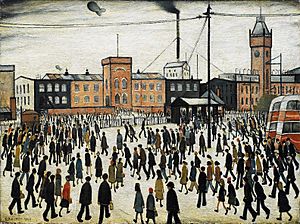
- On the industrial landscape
- "We went to Pendlebury in 1909 from a residential side of Manchester, and we didn't like it. My father wanted to go to get near a friend for business reasons. We lived next door, and for a long time my mother never got to like it, and at first I disliked it, and then after about a year or so I got used to it, and then I got absorbed in it, then I got infatuated with it. Then I began to wonder if anyone had ever done it. Seriously, not one or two, but seriously; and it seemed to me by that time that it was a very fine industrial subject matter. And I couldn't see anybody at that time who had done it – and nobody had done it, it seemed."
- "Most of my land and townscape is composite. Made up; part real and part imaginary ... bits and pieces of my home locality. I don't even know I'm putting them in. They just crop up on their own, like things do in dreams."
- On his style
- "I wanted to paint myself into what absorbed me ... Natural figures would have broken the spell of it, so I made my figures half unreal. Some critics have said that I turned my figures into puppets, as if my aim were to hint at the hard economic necessities that drove them. To say the truth, I was not thinking very much about the people. I did not care for them in the way a social reformer does. They are part of a private beauty that haunted me. I loved them and the houses in the same way: as part of a vision.
- "I am a simple man, and I use simple materials: ivory black, vermilion, prussian blue, yellow ochre, flake white and no medium. That's all I've ever used in my paintings. I like oils ... I like a medium you can work into over a period of time."
- On painting his "Seascapes"
- "It's the battle of life – the turbulence of the sea ... I have been fond of the sea all my life, how wonderful it is, yet how terrible it is. But I often think ... what if it suddenly changed its mind and didn't turn the tide? And came straight on? If it didn't stay and came on and on and on and on ... That would be the end of it all."
- On art
- "You don't need brains to be a painter, just feelings."
- "I am not an artist. I am a man who paints."
- "If people call me a Sunday painter, I'm a Sunday painter who paints every day of the week."
Works

Lowry's work is held in many public and private collections. The largest collection is held by Salford City Council and displayed at The Lowry. Its collection has about 400 works. X-ray analyses have revealed hidden figures under his drawings – the "Ann" figures. Going to the Match is owned by the Professional Footballers' Association (PFA) and is displayed at The Lowry along with a preparatory pencil sketch.
The Tate Gallery in London owns 23 works. The City of Southampton owns The Floating Bridge, The Canal Bridge and An Industrial Town. His work is featured at MOMA, in New York City. The Christchurch Art Gallery Te Puna o Waiwhetu in Christchurch, New Zealand has Factory at Widnes (1956) in its collection. The painting was one of the gallery's most important acquisitions of the 1950s and remains the highlight of its collection of modern British art.
In the early days of his career Lowry was a member of the Manchester Group of Lancashire artists, exhibiting with them at Margo Ingham's Mid-Day Studios in Manchester. He made a small painting of the Mid-Day Studios which is in the collection of the Manchester City Art Gallery.
During his life Lowry made about 1,000 paintings and over 8,000 drawings.
Selected paintings
- 1920 St Augustine's church
- 1928 Irk Place
- 1935 The Fever Van
- 1936 Laying a Foundation Stone — the mayor of Swinton and Pendlebury, laying a foundation stone in Clifton
- 1938 A Cricket Match — set to be auctioned during the 2019 Cricket World Cup
- 1941 Houses on a Hill
- 1943 A Fylde Farm — collected by Queen Elizabeth The Queen Mother and hung at Clarence House
- 1943 Going To Work — painted as a war artist and in the collection of the Imperial War Museum.
- 1945 V.E. Day
- 1946 Good Friday, Daisy Nook — sold in 2007 for £3.8 million (then record price for a Lowry)
- 1947 A River Bank — bought in 1951 by Bury Council for £150 and controversially sold in 2006, for £1.25 million at Christie's, by the Metropolitan Borough of Bury, towards funding a £10 million budget deficit
- 1947 Iron Works
- 1947 Cranes and Ships, Glasgow Docks — acquired by Glasgow City Council at Christie's in November 2005 for £198,400, presently on display at the Kelvin Hall, it was bought specifically for display in the new Riverside Museum
- 1949 Agricultural fair, Mottram-in-Longdendale
- 1949 The Cripples - features number of disabled people in a park, including Lowry as a disabled person (centre). The people are a mixture of imaginary and real people. For example, it is believed that a man known locally known as 'Johnny on wheels' is depicted to the right.
- 1949 The Football Match — not seen in public for two decades before May 2011 when offered for sale at Christie's; later sold for £5.6m – a record price for a Lowry painting.
- 1949 The regatta
- 1950 The Pond — the image was used as a Christmas card by Prime Minister Harold Wilson in 1964
- 1952 Ancoats Hospital Outpatients Hall — a rare internal scene, showing Ancoats Hospital and given to The Whitworth Gallery in 1975.
- 1953 Football Ground — fans converging on Bolton Wanderers's old football ground Burnden Park; painted for a competition run by the Football Association, it was later renamed Going to the Match and was bought by the Professional Footballers' Association for a record £1.9 million in 1999.
- 1954 Piccadilly Gardens, a view of the former sunken gardens in Piccadilly Gardens, Manchester, now in Manchester Art Gallery collection
- 1955 A Young Man
- 1955 Industrial Landscape
- 1956 Fairground at Daisy Nook
- 1960 Old church and steps
Drawings
- 1924 View from a window of the Royal Technical College
- 1924 The Flat Iron Market
- 1928 Newton Mill and bowling green
- 1930 Swinton Industrial Schools
- 1936 Dewars Lane (Dewars Lane is now part of the Lowry Trail in Berwick-upon-Tweed)
- 1942 A Bit of Wenlock Edge
- 1947 Figures in lane
- 1945? St Luke's Church, Old Street, London
- 1953 Agecroft regatta
Stolen Lowry works
Five Lowry art works were stolen from the Grove Fine Art Gallery in Cheadle Hulme, Stockport on 2 May 2007. The most valuable were The Viaduct, estimated value of £700,000 and The Tanker Entering the Tyne, which is valued at over £500,000. The Surgery, The Bridge at Ringley and The Street Market were also stolen. The paintings were later found in a house in Halewood near Liverpool. Only one of the four robbers was caught and convicted; two other men were later convicted for possession of the stolen works. A further "The Skater" a pencil drawing has never been returned although the gallery owner was taken to court found guilty but declared himself bankrupt leaving the owner, Arnold Monk without the drawing he had lent for display.
Attributed works in 2015
In July 2015 three works – Lady with Dogs, Darby and Joan and Crowd Scene – featured in the BBC One series Fake or Fortune?. The programme enlisted the help of various experts to determine whether the paintings were genuine or forgeries. The works in question had been bought in the 1960s by a Cheshire businessman, Gerald Ames, but their provenance was poor, and it was noted that Lowry was "probably the most faked British artist, his deceptively simple style of painting making him a soft target for forgers". All three works were judged to be genuine by a panel of experts, and the total value of the paintings was estimated to be in excess of £200,000. The programme also revealed that while Lowry often claimed to use only five colours (lead white, ivory black, vermillion, Prussian blue and yellow ochre), Lowry was photographed in his studio with titanium white and zinc white stored under his table which he also applied onto his work. The usage of other paints became helpful when determining that the above works were genuine.
Discovered work
The Mill, Pendlebury, a painting never publicly exhibited or featured in any book, was found in the estate of Leonard D. Hamilton, a British-American researcher, after his death in 2019. Hamilton was a Manchester Grammar School boy who studied at Balliol College, Oxford, and Trinity College, Cambridge, before moving to the US in 1949. The work was sold, at Christie's modern British art auction, with an estimate is £700,000 to £1m. The work sold on 21 January 2020, to a private collector, for £2.65m.
Art market
In March 2014 fifteen of Lowry's works, from the A.J. Thompson Collection, were auctioned at Sotheby's in London; the total sale estimate of £15 million was achieved, even though two paintings failed to reach their reserve price and were withdrawn. Thompson, owner of the Salford Express, collected only Lowry paintings, starting in 1982. The auction included the paintings Peel Park, Salford and Piccadilly Circus, London, Lowry's most expensive painting at auction to date, which fetched £5.6 million in 2011 but only £5.1 million in 2014. Lowry painted very few London scenes, and only two depict Piccadilly Circus.
In popular culture
- In January 1968 rock band Status Quo paid tribute to Lowry in their first hit single "Pictures of Matchstick Men".
- In 1978 Brian and Michael reached number one in the UK Singles Chart with the tribute single "Matchstalk Men and Matchstalk Cats and Dogs".
- Manchester rock band Oasis released a music video for the song "The Masterplan", to promote their 2006 compilation album Stop the Clocks, using animation in the style of his paintings. The video follows the band in many famous Lowry scenes, including Man Lying On A Wall and Fairground At Daisy Nook, but also includes quirky modern-day additions such as a cars and a satellite dish.
- In August 2010 the play Figures Half Unreal was performed by the Brass Bastion theatre company in Berwick-upon-Tweed where Lowry was a regular visitor.
- On 1 November 2012 Google celebrated his 125th birthday with a Google Doodle.
- Lowry features in the chorus of the Manic Street Preachers' song "30-Year War" on their 2013 album Rewind the Film:
So you hide all Lowry's paintings
For 30 years or more
'Cos he turned down a knighthood
And you must now settle the score
- In the BBC's Fake or Fortune? experts determined whether three works were genuine Lowry paintings or forgeries. Experts analysed the paint used in one of the paintings, but the white paint did not match the flake white Lowry claimed to have always used. Lowry claimed to have only used five colours, flake white (lead white), ivory black, vermillion red, Prussian blue and yellow ochre, produced by Winsor & Newton. Photographic evidence from the 1950s, however, showed that he had experimented with both titanium white and zinc white: Darby and Joan contained traces of zinc white. The same painting was also plainly visible in a contemporary BBC documentary film.
- The 2019 film Mrs Lowry & Son, directed by Adrian Noble and starring Vanessa Redgrave and Timothy Spall, depicts the fraught relationship between Lowry and his elderly bed-ridden mother between 1934 and 1939.
- Sunday painter by Dutch band Nits is a song inspired by Lowry.
Images for kids
See also
 In Spanish: L. S. Lowry para niños
In Spanish: L. S. Lowry para niños


